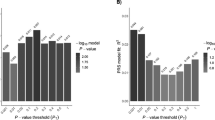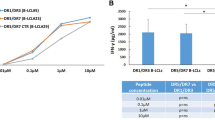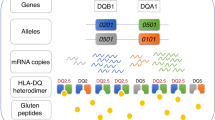Abstract
Coeliac disease is an autoimmune disorder, characterised by villous atrophy of the small intestine, which results from a T-cell-mediated response to gluten-derived peptides. The cytotoxic T-lymphocyte-associated protein 4 (CTLA-4) is involved in the regulation of T-cell activation and the CTLA4+49 A/G polymorphism in exon 1 has been implicated in several autoimmune disorders, including coeliac disease. However, this polymorphism was recently excluded as being the causal variant in Graves' disease, autoimmune hypothyroidism and type I diabetes mellitus. This causal variant was mapped to the 3′ region of CTLA4, with the CT60 polymorphism showing the strongest association. The aim of this study was to determine the role of the CTLA4 gene in coeliac disease in the Dutch population. The +49 A/G and CT60 polymorphisms were genotyped in a case–control cohort of 215 patients and controls. The frequency of the +49 G-allele was increased in cases, although not significantly. However, the frequency of the CT60 G-allele was increased with borderline significance in coeliac disease patients (P=0.048), although the genotype distributions did not show a significant difference between cases and controls. These results indicate the involvement of the CTLA4 gene in coeliac disease development. The haplotype carrying the CT60 G-allele was shown to be associated with lower mRNA levels of the soluble CTLA-4 isoform, providing a possible mechanism for the T-cell-mediated destruction of the small intestine.
Similar content being viewed by others
Introduction
Coeliac disease is an autoimmune disorder and is strongly associated with the HLA region. The majority of the patients express the HLA-DQ2 protein and almost all remaining patients express HLA-DQ8. Coeliac disease is characterised by an inappropriate T-cell response to gluten in the small intestine. Gluten proteins are present in wheat, barley and rye, and gluten-derived peptides can bind to HLA-DQ2 and DQ8 on the surface of antigen-presenting cells. These complexes are recognised by gluten-specific T cells in the gut of coeliac disease patients, resulting in inflammation, crypt hyperplasia and villous atrophy.1, 2 The HLA association only partly explains the genetic contribution, so non-HLA genes must also be involved in coeliac disease.3
The cytotoxic T-lymphocyte-associated protein 4 (CTLA-4) and the cell designation 28 antigen (CD28) are involved in the regulation of T-cell activation. CD28 induces the T-cell response, whereas CTLA-4 has an inhibitory effect.4 Owing to their functions they are interesting candidate genes for autoimmune disorders. The genes encoding these proteins are both located within a 150 kb region on chromosome 2q33–34. The A/G polymorphism at position +49 in exon 1 of the CTLA4 gene has been extensively studied in autoimmune disorders, and association with type I diabetes mellitus,5 Graves' disease,6, 7 Hashimoto's thyroiditis8 and multiple sclerosis9 has been reported (see, for a review, Kristiansen et al10). It is likely that coeliac disease shares a common genetic background with other autoimmune diseases, so the CTLA4 gene may be involved in coeliac disease as well. Indeed, association between the +49 A/G polymorphism and coeliac disease was reported in several populations.11, 12, 13 However, a recent publication showed that the causal variant involved in Graves' disease, autoimmune hypothyroidism and type I diabetes mellitus is most probably located in the 6.1 kb 3′ region of the CTLA4 gene, and the +49 A/G polymorphism could be rejected as a causal variant.14 The most strongly associated polymorphism in this 6.1 kb region was CT60. We therefore investigated the contribution of the CTLA4 gene to coeliac disease risk in the Dutch population by genotyping the +49 A/G and CT60 polymorphisms in a Dutch case–control cohort.
Subjects and methods
Subjects
A total of 215 independent, biopsy-proven coeliac disease patients of Dutch origin were available for this study. Their mean age was 39 years and 65% were female. The control group consisted of 215 sex- and age-matched independent Dutch individuals. The study was approved by the Medical Ethics Committee of the University Medical Centre Utrecht and written informed consent was obtained from all the participants.
Genotyping
Genotypes of the A/G polymorphism at position +49 of the CTLA4 gene were determined by PCR-restriction fragment length polymorphism (PCR-RFLP) with the Fnu4HI enzyme. The fragment containing the polymorphism was amplified with primers 5′-TTG CCT TGG ATT TCA GTG GC-3′ and 5′-CTG CTG AAA CAA ATG AAA CCC-3′, resulting in a fragment of 175 bp. Digestion with Fnu4H1 of the product containing the G-allele resulted in fragments of 42 and 133 bp. The genotyping procedure was verified by sequencing of three samples with predicted genotypes AA, AG and GG, respectively. These three samples were included as positive controls in each of the five sample plates. The CT60 A/G polymorphism was genotyped using Assay-by-Design on the TaqMan 7900HT system (AppliedBiosystems).
Statistical analysis
Allele and genotype frequencies of the CTLA4+49 A/G and CT60 polymorphisms were determined in cases and controls. Differences in global allele and genotype distributions were tested for significance by means of a χ2 test using 2 × 2 or 2 × 3 contingency tables, respectively. The genotype frequencies were tested for Hardy–Weinberg equilibrium by χ2 analysis, with a value of P<0.05 considered as not in Hardy–Weinberg equilibrium. Odds ratios were calculated using the Woolf–Holdane correction. Haplotypes of the two polymorphisms were estimated using the SNPHAP program (D Clayton; available from http://www-gene.cimr.cam.ac.uk/clayton/software/).
Results
The +49 A/G polymorphism in the CTLA4 gene could be genotyped in 210 cases and 208 controls (Table 1). The genotypes in the controls were in Hardy–Weinberg equilibrium (χ2=0.48, P=0.49). The frequency of the G-allele was slightly increased in the coeliac disease patients, but this difference was not significant. The distribution of the three genotypes was not significantly different between cases and controls. However, the GG-genotype was more prevalent in the coeliac disease patients, with a frequency of 18% in cases compared to a frequency of 11% in controls (OR 1.78, 95% CI 0.99–3.31, P=0.038).
The CT60 polymorphism could be genotyped in 215 cases and 213 controls (Table 2), and the genotypes in the controls were in Hardy–Weinberg equilibrium (χ2=0.80, P=0.37). The G-allele was significantly more frequent in cases (P=0.048), and the frequency of the GG-genotype was also increased in cases, although not significantly (OR 1.46, 95% CI 0.94–2.30, P=0.076).
The two polymorphisms formed three haplotypes: +49A-CT60A (42% in cases vs 49% in controls), +49G-CT60G (39% in cases vs 34% in controls) and +49A-CT60G (19% in cases vs 17% in controls), respectively, which were not significantly differently distributed between cases and controls (data not shown).
Discussion
The CTLA4 gene has been implicated as a general susceptibility gene for autoimmune diseases.10 The +49 A/G polymorphism is the most extensively studied, as this is the only polymorphism in the CTLA4 gene that alters an amino acid.14 The G-allele encodes an alanine residue at codon 17 of the protein, whereas the A-allele encodes a threonine residue. Type I diabetes mellitus, Graves' disease, Hashimoto's thyroiditis and multiple sclerosis have all been associated with the G-allele. So the codon 17 alanine residue seems a common denominator for autoimmunity. However, the +49 A/G polymorphism was recently excluded as a causal variant and strongest disease association was observed with the CT60 A/G polymorphism.14 Two very common CTLA4 haplotypes were present: one protective haplotype with an A-allele at position +49 and at CT60, and one disease-susceptible haplotype with a G-allele at position +49 and at CT60. More importantly, the disease-susceptible haplotype encodes an alternatively spliced CTLA-4 mRNA, resulting in lower mRNA levels of the soluble CTLA-4 isoform compared to the protective haplotype.
The involvement of the CTLA4+49 A/G polymorphism in coeliac disease has been studied by several groups. Positive association with the A-allele was reported in French and Swedish/Norwegian populations,11, 12, 13 but was absent in Italian, Tunisian and Finnish populations and in a combined sample of families from Northern Europe.15, 16, 17 These conflicting results may be due to population-specific effects. However, association could also be absent due to the occurrence of a recombination event between the +49 A/G variant and the disease-causing variant in the 6.1 kb 3′ region of CTLA4. This would also explain the observed association between coeliac disease and the +49 A-allele in several populations, while other autoimmune disease were shown to be associated with the G-allele. Therefore, genotyping a polymorphism from the 6.1 kb region 3′ of CTLA4, like CT60, would be a better choice for studying the involvement of the CTLA4 gene in disease susceptibility.
The +49 A/G and the CT60 polymorphisms were both genotyped in our cohort of Dutch coeliac disease patients and controls. Positive association between CT60 and coeliac disease was observed, with an increased frequency of borderline significance of the G-allele in cases (P=0.048). The +49 G-allele was also increased in cases, but statistical significance was not reached due to the presence of the recombined +49A-CT60G haplotype in the Dutch population. The genotypes of both polymorphisms were not significantly differently distributed between cases and controls. The CT60 G-allele is associated with a slightly increased risk for coeliac disease in the Dutch population (OR=1.31, 95% CI 0.99–1.73). A large effect of the CTLA4 locus was not to be expected, as there was no evidence for linkage to the CTLA4 region in our genome-wide screen in Dutch affected sibpairs.18 However, support for linkage was present in Scandinavian populations and a combined sample of families from Northern Europe.17 The CT60 G-allele may be associated with a larger risk in these populations.
This study indicates the involvement of the CTLA4 gene in coeliac disease. These results should be confirmed in a larger data set, which would also allow more accurate risk estimations. Especially those populations in which association with the +49 A-allele was observed should be genotyped for the CT60 polymorphism. The risk conferred by the CTLA4 gene is probably mediated by the disease-susceptible haplotype, associated with lower mRNA levels and possibly with lower protein levels of the soluble CTLA-4 isoform. This may result in a disruption in the regulation of the T-cell response by CTLA-4 and CD28, leading to a T-cell-mediated destruction of the gut. Comparison of mRNA levels of the soluble CTLA-4 isoform in small intestinal tissue from coeliac disease patients and normal controls may provide more insight into the role of the CTLA4 gene in coeliac disease pathogenesis.
References
Sollid LM : Molecular basis of celiac disease. Annu Rev Immunol 2000; 18: 53–81.
Schuppan D : Current concepts of celiac disease pathogenesis. Gastroenterology 2000; 119: 234–242.
Louka AS, Sollid LM : HLA in coeliac disease: unravelling the complex genetics of a complex disorder. Tissue Antigens 2003; 61: 105–117.
Greenfield EA, Nguyen KA, Kuchroo VK : CD28/B7 costimulation: a review. Crit Rev Immunol 1998; 18: 389–418.
Marron MP, Raffel LJ, Garchon HJ et al: Insulin-dependent diabetes mellitus (IDDM) is associated with CTLA4 polymorphisms in multiple ethnic groups. Hum Mol Genet 1997; 6: 1275–1282.
Donner H, Rau H, Walfish PG et al: CTLA4 alanine-17 confers genetic susceptibility to Graves' disease and to type 1 diabetes mellitus. J Clin Endocrinol Metab 1997; 82: 143–146.
Heward JM, Allahabadia A, Armitage M et al: The development of Graves' disease and the CTLA-4 gene on chromosome 2q33. J Clin Endocrinol Metab 1999; 84: 2398–2401.
Donner H, Braun J, Seidl C et al: Codon 17 polymorphism of the cytotoxic T lymphocyte antigen 4 gene in Hashimoto's thyroiditis and Addison's disease. J Clin Endocrinol Metab 1997; 82: 4130–4132.
Harbo HF, Celius EG, Vartdal F, Spurkland A : CTLA4 promoter and exon 1 dimorphisms in multiple sclerosis. Tissue Antigens 1999; 53: 106–110.
Kristiansen OP, Larsen ZM, Pociot F : CTLA-4 in autoimmune diseases – a general susceptibility gene to autoimmunity? Genes Immun 2000; 1: 170–184.
Djilali-Saiah I, Schmitz J, Harfouch-Hammoud E, Mougenot JF, Bach JF, Caillat-Zucman S : CTLA-4 gene polymorphism is associated with predisposition to coeliac disease. Gut 1998; 43: 187–189.
Naluai AT, Nilsson S, Samuelsson L et al: The CTLA4/CD28 gene region on chromosome 2q33 confers susceptibility to celiac disease in a way possibly distinct from that of type 1 diabetes and other chronic inflammatory disorders. Tissue Antigens 2000; 56: 350–355.
Popat S, Hearle N, Wixey J et al: Analysis of the CTLA4 gene in Swedish coeliac disease patients. Scand J Gastroenterol 2002; 37: 28–31.
Ueda H, Howson JM, Esposito L et al: Association of the T-cell regulatory gene CTLA4 with susceptibility to autoimmune disease. Nature 2003; 423: 506–511.
Clot F, Fulchignoni-Lataud MC, Renoux C et al: Linkage and association study of the CTLA-4 region in coeliac disease for Italian and Tunisian populations. Tissue Antigens 1999; 54: 527–530.
Holopainen P, Arvas M, Sistonen P et al: CD28/CTLA4 gene region on chromosome 2q33 confers genetic susceptibility to celiac disease. A linkage and family-based association study. Tissue Antigens 1999; 53: 470–475.
Popat S, Hearle N, Hogberg L et al: Variation in the CTLA4/CD28 gene region confers an increased risk of coeliac disease. Ann Hum Genet 2002; 66: 125–137.
van Belzen MJ, Meijer JW, Sandkuijl LA et al: A major non-HLA locus in celiac disease maps to chromosome 19. Gastroenterology 2003; 125: 1032–1041.
Acknowledgements
We thank Winny van der Hoeven and Alfons Bardoel for collecting the cases and controls, Jos Meijer for re-evaluating the initial biopsy specimens of the patients included in this study and Jackie Senior for improving the manuscript. This study was supported by a grant from the Netherlands Digestive Diseases Foundation (WS 97-44).
Author information
Authors and Affiliations
Corresponding author
Rights and permissions
About this article
Cite this article
van Belzen, M., Mulder, C., Zhernakova, A. et al. CTLA4+49 A/G and CT60 polymorphisms in Dutch coeliac disease patients. Eur J Hum Genet 12, 782–785 (2004). https://doi.org/10.1038/sj.ejhg.5201165
Received:
Revised:
Accepted:
Published:
Issue Date:
DOI: https://doi.org/10.1038/sj.ejhg.5201165
Keywords
This article is cited by
-
Targeted modification of wheat grain protein to reduce the content of celiac causing epitopes
Functional & Integrative Genomics (2012)
-
The shared CTLA4-ICOS risk locus in celiac disease, IgA deficiency and common variable immunodeficiency
Genes & Immunity (2009)
-
Meta-analysis of genome-wide linkage studies across autoimmune diseases
European Journal of Human Genetics (2009)
-
Searching for genes influencing a complex disease: the case of coeliac disease
European Journal of Human Genetics (2008)
-
Genetic Polymorphisms of LMP/TAP Gene and Hepatitis B Virus Infection Risk in the Chinese Population
Journal of Clinical Immunology (2007)



